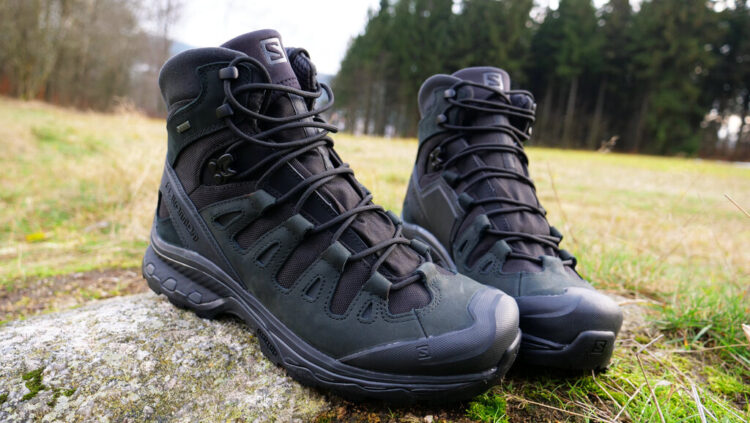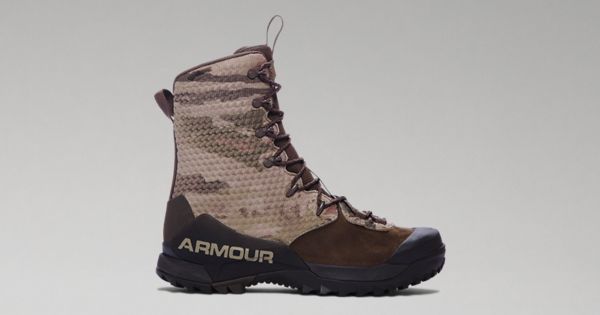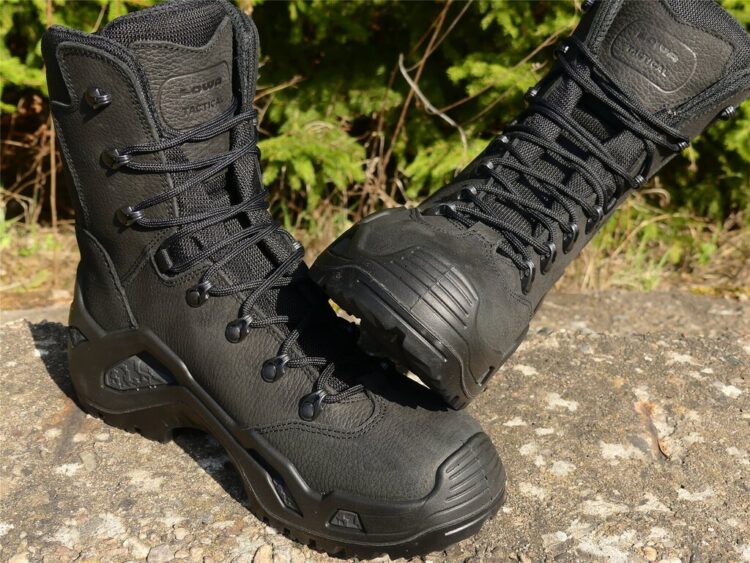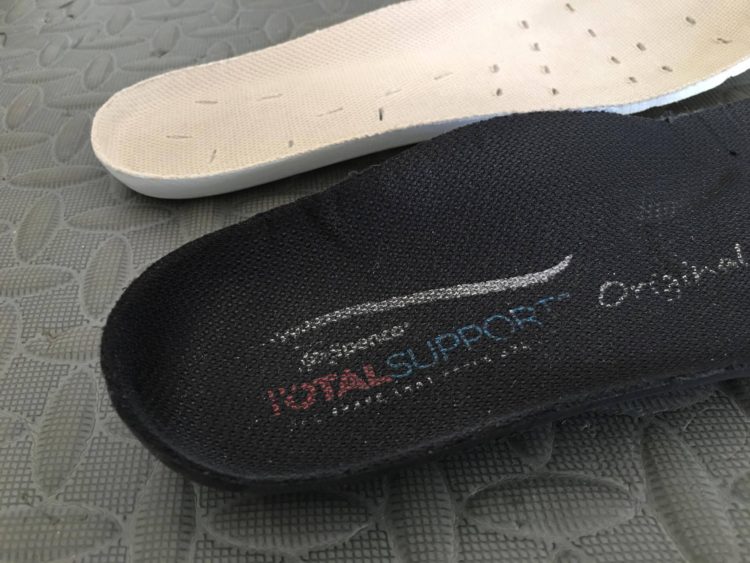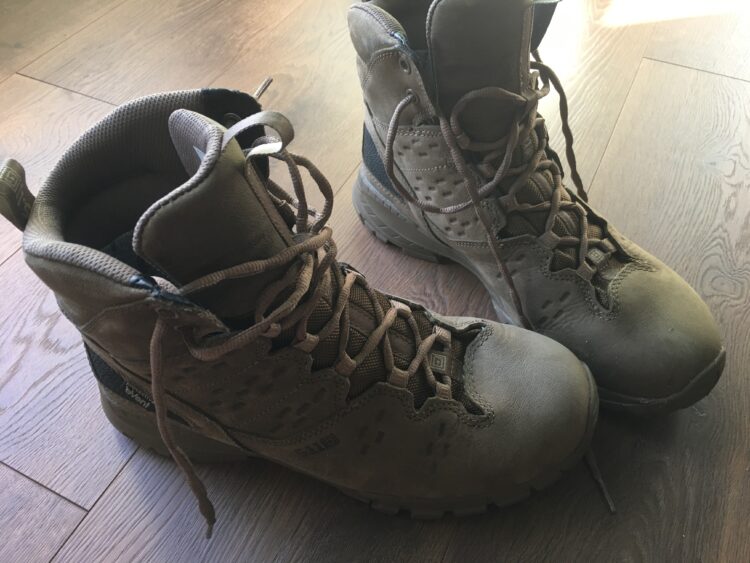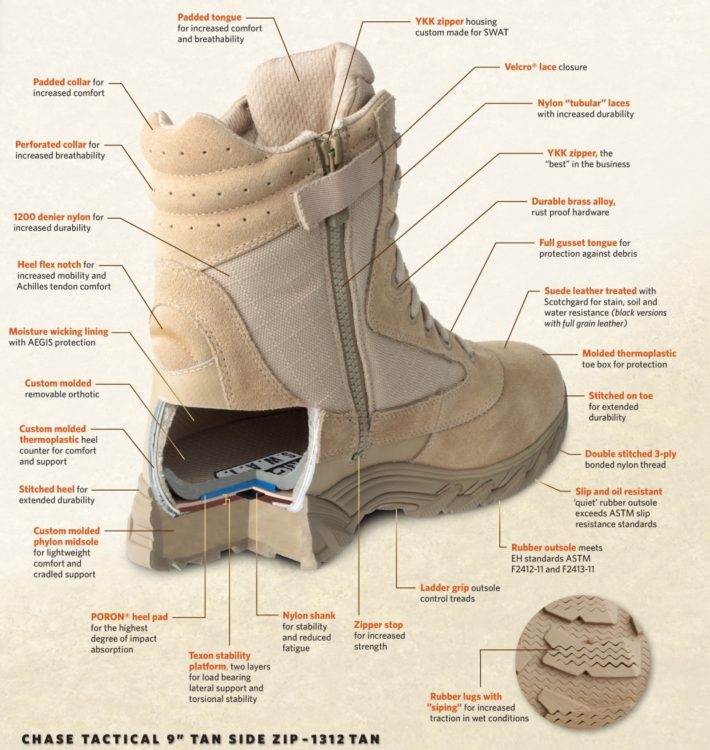Finding the proper boots for your feet may seem difficult but if you have a few good bits of information the selection process will be easier. There are different types of boots in the marketplace for different needs. Know exactly what you’ll need your boots for. Components of a boot such as the tongue, the eyelets, the last and the outsole are made of different materials. Like the parts of a car each boot component has an intended purpose and good boot manufacturers will construct those parts in such a manner to give users the best ride.
A boot should fit your profession or hobby. Some of the things to think about:
- Will they be used in hot or cold conditions?
- Will they be used in wet or dry conditions like those found in jungles or deserts?
- Will they be used in urban sprawls with concrete streets and rubble or some of natural environment? In places like those you’ll encounter things such as thorns, rocky terrain, broken glass and nails in boards.
- Will they be used in conditions where more traction is needed such as going over mossy rocks or oily streets?
- Do you need a lot of ankle support or less?
- Do you have an injury that affects your gait?
- Will you need a wider outsole for a more stable-step to go over rubbish or scree?
- Will you need a light-weight boot for speedy travel or can you go slower with a heavier boot that add protection?
Boots come in identifiable types of shapes and have distinct features. There are many different kinds of boots on the market and each has its own intended purpose such as the work boot, traditional motorcycle boot, or dress boot. Understanding a bit more about the boot types, the cut of the boot materials that go into the uppers, lowers, midsoles, outsoles and other parts of a boot, and the boot fit will make your shopping time most productive.
An ideal boot must provide superior traction and excellent support in any environment you’re in or in any situation you face. Are you a police officer, firefighter, military or just out for a stroll with your IWB holster and pistol?
For the purposes of this article I am going to present the overall features to look for in boots. I will also include some recommendations based on what is popular on the market but also recommended by people who actually used them. When shopping for tactical boots try to purchase the best boots that meet your needs while spending what you can reasonably afford. Expensive boots might not be the best boots for your feet. A more affordable boot might be a better way to go.
Manufacturers attempt to come up with the right combination of price, weight, durability, function, warranty, and comfort. Most good boots come in around the $150.00-$200.00 range. Look for items on sale. There are many good boots that will fit your needs in the $100-$120.00 range. Look for last year’s model and hunt for coupon codes.
- Standard issue boot Standard issue boots for the military trooper might be different from the duty boots issued to the lawman. The overall design of a standard issue boot was envisioned to give the user good ankle support, stability and protection. They are rugged and reliable while the design and features are largely unimaginative. The boots are flexible and provide good shock absorption for the average user. The insole within helps to fight bacteria and moisture while adding cushioning. The outsoles being flat and boxy are good for most terrain. The outsole is crafted to provide traction on most terrains and conditions but not ideal for the street or jungle conditions. The boot is good for training and for combat yet lacks the sleeker build and lightness of most tactical boots.
- Tactical boots Tactical boots are designed to give the user maximum agility and traction over any terrain, whether it be the street or the desert, while offering good foot protection. Tactical boots will feel less like a boot and more like an athletic shoe. The boot should not require a break in period because it is very flexible. A good tactical boot will have multi-directional lugs which provides stability to prevent stumbling and a good heel to toe shape to allow dynamic reaction when pushing off or twisting. Good, shapely overlays allows flexibility, comfort and protection. Tactical boots are designed to handle uneven or slippery terrain with exceptional grip. The outsoles on tactical boots tend to have an upward curvature while standard issue boots are usually flatter making for slower response times when pivoting or moving forwards.
- Hiking (walking) boots are specifically designed for protecting the feet and ankles during outdoor activities such as backpacking, climbing, mountaineering, and hunting. The focus on hiking boots is comfort and protection.
- Jungle boots Jungle boots are a type of combat boot meant for use in wet, hot and humid environments where a standard issue boot would hinder the user. Jungle boots are designed for comfort and durability and feature a breathable material, usually canvas, and also have water-drainage ports in the midsole. The water drainage ports allow the boot to dry quickly and for air to circulate freely. Moisture will evaporate and lessen the chance for the user to develop ulcering or blistering on the feet. The outsole will feature an aggressive traction pattern. A jungle boot should be puncture resistant because users can step onto hazardous work surfaces particularly when crossing rivers and streams. Slip resistance is a must for jungle environments.
- Hybrid boots hybrid boots are the next gen in the boot world. They are made using the best features of running shoes and combat boots. Hybrid boots such as the Hoka Tor feature a meta-rocker which allows the user to move speedily forward. Their Meta-Rocker works nicely as a forward assist and it’s needed in order to compensate for the high stack height of their collar. The Under Armour Infil Ops features a breathable GORE-TEX®, high abrasion membrane upper. Both hybrid boots provide good ankle stability, comfort, and protection. Hybrid boots are lightweight, anatomically molded, have easy-on-off access, may have anti-microbial insoles, and comfortable yet sturdy via heel cups for added support. Many hybrid boots are tactical boots. In the last decade tactical boot manufacturers have blended elements of tactical boots and made them more responsive; the sports brand Under Armour is on the cutting edge of doing this; however, some of these boots fall apart easily without hard use.
UA Infil Ops GORE-TEX®. The UA uses a high abrasion textile upper they call Anafoam™ as an overlay to give the boot an anatomically molded precise fit & support like a running shoe. The boot is lightweight. Check with your department to see if they meet its footwear policy. Some user reviews of this have been mixed. Some love it while others believe it doesn’t hold up. The price is what you’d expect for a UA boot. $239.00
Boots should protect your feet and ankles, feel comfortable walking in, allow you to travel over most terrain and hold up to more than just average wear and tear.
Uppers
Leather: Leather, natural or synthetic collars and uppers should encapsulates your ankle very well due to a well-thought out construction. Boot uppers mostly made of a soft, water-resistant mesh-material will enhance breathability. Boots should provide a great deal of padding, softness, and comfort around the feet and ankles. A light-weight material is well-suited for using in hotter climates and climates that aren’t frigid. Thin uppers such as the material used in jungle boots is great for rapid walking. A good mixture of materials allows the feet to breathe and not feel hot or cold. Buffed leather, known as nu-buck, is a full-grain leather that has been buffed to resemble suede. It is water-resistant and fairly durable.
Leather is the best material to use for constructing durable, water-resistant footwear. A substitute material should be used if leather is not used. Nylon/split-grain leather combinations are best for breathability. Leather has excellent properties for use in footwear meant for heavy loads, rugged terrain and distant travel. A good break in-time is need when choosing leather as a boot material.
Collar: The inside back, top portion of the boot that provides stability around the ankle. Some people like a stiffer collar while others may like it to be less rigid. Some collars can irritate the ankles and calves. Try them on and walk in them to see how they feel. Some collars might irritate the calf muscles of your legs. Perhaps go with a shorter model.
Lowa Z-8N GTZ Excellent for handling rugged terrain and adverse environmental conditions. Cross-directional lug pattern provides extra grip. GORE-TEX waterproofing technology in the liner keeps your feet dry in rain, mud or snow. A nylon shank provides rigidity and arch support through the middle of the boot, so it can be worn day in and day out regardless of the weather. $419.00
Collar lining: The part of the collar that provides comfort around the ankle. Some manufacturers use a plusher collar and lining while others may have a leaner collar in order to cut down on weight. Lowa Z-8N GTX
Insulation: Synthetic insulation is good for warmth and is usually found in some mountaineering boots.
The heel cup within the insert of the LALO boot (tan) might be too lean for some. I recommend adding your own inserts as I have done.
Heel cup: This is the heel portion of the insole of your boot. A good heel cup can prevent your foot from sliding. Those with thin feet should look for smaller sizes in a boot or use thicker socks or a combination of thicker/thinner socks with a good boot insert.
An OrthoLite imperial foodbed ads moisture wicking and long lasting comfort. The XPRT 3.0 WP also features a Ghillie lacing system; sausage laces keep the fit locked in. $199.00
Lugs: Lugs are just one part of the boot that gives it motion control. Lugs are the bumps on the outsole (bottom of the boot) of a boot or shoe. When buying a boot you want to look for well-spaced wide lugs because these are going to improve your grip or look for numerous well-placed smaller lugs. Good lugs will mean you can get good traction. Good usage of lugs and flex grooves for incredible traction and balance. Rolling your ankle on technical downhills won’t be easy to do and this gives you confidence to kick out your stride.
Good usage of lugs and flex grooves for incredible traction and balance. Hoka Tor: Flex points at the toe box and ankle for generous movement. Boot makes use of eyestays, pulltab, meta rocker and heel brake. $119.00
Lace Keepers and Eyestays: The eyelets are the holes the boot laces pass through. The eyelets of a boot should be large enough and smooth enough so you can easily and quickly adjust your laces.
Eyestays are material that provide structure to the eyelets. Generally made of a sturdy fabric so that a lace will not tear through the eyelet.
Well-placed lace keepers, eyestays and strong laces make a boot most effective. Boots should be easy to put on and take off. Strong laces are held in place by eyestays and should fit through sets of lace hooks and eyelets. A good combination of leather and nylon done smartly and cut with flex points, where it is needed-at the edge of the toebox and at the ankle, make a good boot great.
Eyestays help pull the boot tighter around the throat. Ankle stability is further helped by strong laces which extend all the way up from the vamp, along the throat of the boot, and to the top of the collar. This allows you to adjust the overall tightness and fit the way you want it.
Mudguard: The Mudguard is the boot pattern part along the forward part of the boot along the edge of the outsole. Good protection for limiting wear from abrasive items such as rocks, branches and street.
Pulltab: Fabric that helps you pull your boot quickly over your foot.
The saddle: Material that dresses the quarter panel up but also adds more structure to the boot. The saddle, or the middle of the boot upper, should have a nicely lain expanse of leather to protect the flanks of your foot. Flex points at the toe box and ankle can make for generous movement.
Synthetics: Synthetics materials in boots are usually made from polyester, and nylon or synthetic leather. They dry quickly, are light-weight yet may not be as durable as leather; check with the salesperson to find out how tough the material is. They’re cheaper than leather but will start to wear much faster.
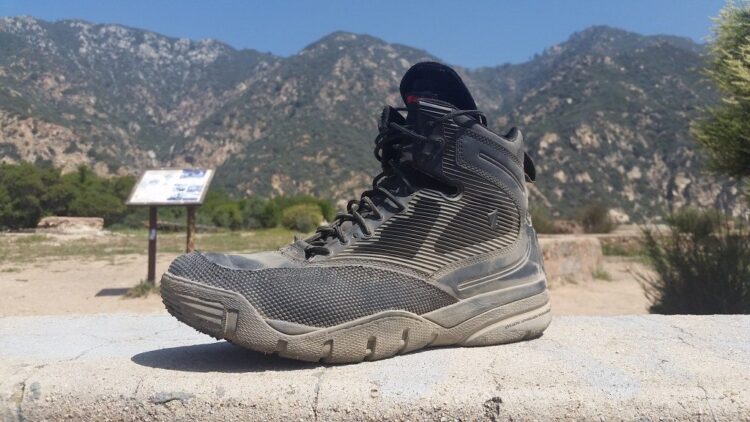
LALO Tactical uses a ceramic overlays on their toebox. Look for good toe protection. The saddle (sides of the boot) are covered with a breathable patterned material.
Toebox: The front part of the boot for the space around the toes. Look for a toe box with a wide enough area for your fore-foot. The toebox should be ample and let the foot sit nicely in the heel cup and boot insert without the foot feeling choked. Many boot fronts have a generous mudguard/toe bumper that wraps nicely over the toe to shield your toes from impact if you strike an object.
Throat: The opening of a boot. Ensure you get a boot with a wide enough throat for your foot.
Tongue: Soft elongated flap that fits over the top of the foot to protect the tendons and blood vessels from pressure caused by the laces. The tongue is a separate strip on the upper. It makes it easier to put your boots on and take them off. It also prevents the laces from rubbing against the instep of your foot. Look for a gusseted tongue to keep out debris.
Lace Keeper, Eyestays and strong laces hold this all together really-well
Waterproofing: Waterproof membranes via millions of tiny pores allows boots to breathe well and keeps water out while allowing your moist feet to dry in due time. Well made boots will have good waterproofing properties; creeks and puddles are no match for a quick, ankle-deep stride into water but may encourage the feet to sweat on hotter days. A ventilated mesh textile combined with leather or sturdier synthetics may be a good choice.
Weight Find something that isn’t heavy. You want to stay quick on your feet.
Zippers Look for quality zippers. Many cheaply made boot zippers will break soon after you wear them.
Inner
Last: The last is a layer of material which is stitched to the upper. It is the shape of the foot. The sockliner is placed on top of the last.
Midsoles: The midsole is a layer of spongy material between the outsole and the upper. These cushioning materials combine bounce and durability. The material is usually Ethylene-vinyl acetate foam (EVA). EVA is a flexible, lightweight and soft foam. EVA or sometimes Polyurethane foam sits below the upper and above the outsole, providing protection from impact forces and oftentimes encasing nonfoam technologies, such as GEL or Air, to increase durability and protection.
EVA is less expensive than polyurethane and cushier. Hiking boots generally use polyurethane as it is usually firmer and more durable than EVA. Both materials improve boot cushioning.
I have not tried this boot but this illustration highlights many good features to look for in a good boot.
Bottom
Flex grooves: Channels that help the boot flex along with the natural movement of the foot. The combination of pods, lugs or studs and features such as the flex grooves can determine how responsive a boot is during your activities.
Flex grooves with textured outsoles increase mobility and maintains maximum grip even on most wet surfaces. The boot upper compensates just right while doing twisting motions as the boot lower provides excellent grip and stability.
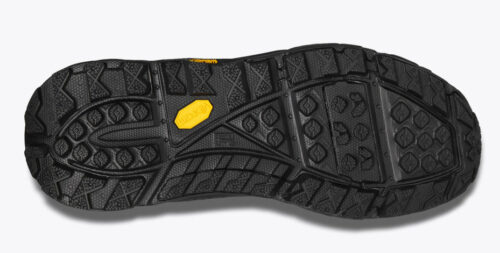
Good usage of lugs and flex grooves for incredible traction and balance
Heel brake: Heel brakes reduces your chance of sliding during descents.
Plates: Plates are semiflexible inserts and positioned between the midsole and the outsole. The LALO Tactical boot line uses a thermoplastic plate across the entire bottom of their boot. (TPU is firm and usually used to make ski boots or inline skates). Plates prevent the feet from getting bruised by rocks.
Outsoles: The outsole has about ~⅓ more surface area than normal shoes. A boot with a good offset allows explosive starting and stopping movements such as moving to shoot targets, going into the prone position, getting up and running straight, or turning to pivot; you will not be unstable as you go through your motions such as following behind your partner. A boot with too high of a outsole can prevent a quick reaction due to the stack height.
Shanks: Shanks are inserts, usually 3–5mm thick, that are sandwiched between a boot’s midsole and outsole. The purpose is to stiffen the boot under the arch, which makes the middle portion of the boot firmer. Some of them wrap the shank up into the medial post part of the boot to add more stability and thus allowing it to function more like a medial post. Shanks add stiffness to the midsole for load-bearing.
Inserts
Orthotics, generally known as inserts or insoles, are medical devices that are inserted into your footwear (boots or shoes) in order to improve the function of the foot. Orthotics are useful because they alter the shock or load placed upon your foot by changing the alignment and movement of the foot when it presses upon the insert within the shoe or boot.
Over the counter (OTC) devices considered to be orthotics are various. Some of these are known as: shoe inlays, heel cushions or cups, silicone pads, shock reducing insoles, heel cushions or cups, and even felt.
Support must be used properly if they are to prevent injury.
Most over-the-counter supportive devices available at the local running shops and pharmacies such as CVS or Walgreen’s are adequate for most people however a specialist is worth seeing if your issue doesn’t go away. A specialist can determine the nature of the lower extremity problem and can prescribe and create custom orthotics if necessary.
When shopping for orthotics keep in mind the design of a orthotic will determine how effective it is. Some orthotics cushion your foot and other types change how you land. Orthotics, such as heel cups, are good for walking while insoles are best used for running.
Shown below are heatable and moldable insoles.
Orthotics are a good short-term solution to help prevent injuries. Over the counter (OTC) inserts can be purchased today for less than $20.00 and upwards of $50.00. The most expensive orthotics may not necessarily be the best for your issue. At one time inserts could only be purchased through manufactures that created custom inserts at a cost of $300-$500.00. Not everyone is the same. Injuries such as bunions or stress fractures should be discussed with a doctor or your physical therapist. Some people aren’t going to get relief with inexpensive inserts.
How does a orthotic work? An orthotic aids support to your heel, arch or forefoot and in turn this can help reduce pain in other areas of your body such as your back or knees. Orthotics, namely insoles, are usually used in conjunction with a good pair of shoes.
More flexible insoles can be used when the force exerted by the foot is minor and more rigid insoles are used when the force is great. Soft insoles do not last as long as rigid insoles. When complex movements such as basketball or soccer are required, it is best to find a more flexible and softer insole. Activities such as running, walking or hiking require less complex movements and so a firmer and less flexible insert works best.
The two most common insoles are Comfort Insoles and Support Insoles.
Comfort Insoles
Comfort insoles have a shock absorbing design and are meant to provide comfort to people who experience foot pain and tired feet. These work by reducing shock to the feet. As people age they have reduced padding on the bottom of their feet. A good insole provides added comfort where the sensation once lacked.
People that stand for long periods of time or are walking for extended periods may find relief from comfort insoles. Comfort insoles can be flat shaped and feature a foam or gel. Insoles can be a heel insert, 3/4 length or a full length. Runners and users of boots, such as members of the military, should look for a full length insole.
Sometimes a comfort insole will not provide sufficient foot support. Avoid soft materials that go flat when pressure is applied. They have a tendency to degrade quickly. Ensure that the insole is firm enough that it doesn’t collapse under the force of your stride. The foot might require a firmer material. Look for brands with models that support your feet adequately. Models are made for people with low, medium and high arches.
Another option is going with a moldable insole that blends the best of both OTC and custom-fit orthotics. These allow you to mold the precise shape of your foot using heat treatment. The problem with moldable orthotics, however, is that if you don’t get a proper imprint, your insoles will be virtually useless.
Heat moldable insoles are available on the market which can be molded to the shape of your foot simply by heating them in a microwave oven at a low temperature. Simply heat the insole and then stand in them until they form to your foot. Lowering yourself into a squatting position helps shape the insole around the body of your foot. Running stores that sell running shoes usually have trained staff on hand that can mold it for you once they check your gait and foot shape.
Support (Sport) Insoles
These feature a harder material as feet have a tendency to supinate or pronate overly much when running or even walking. Look for insoles that provide increased stability and structural support. Increased stability will provide more comfort than direct cushioning. Boots will require high-volume insoles while cycling shoes, and running shoes require less volume insoles.
It is best when purchasing insoles to bring the sock and shoes/boots you will be putting the insole in. Custom insoles can last years while OTC last about 6 months, depending on your weight and activity. Check the wear from time to time and rotate them out as necessary. Keep in mind that insoles are not meant for the long-term.
Conclusion: There are a lot of really good models in the market place. There is no need to spend a lot of money. There are many good tactical boots within the $120.00-$175.00 range; there’s just no need to spend $300.00 or more unless it meets your needs. Will you be using it to walk through streams and over rocky paths? Will you more than likely chase a suspect across broken glass, rebar and lumber?
Try to shop mid day or after work when your feet are swollen. Bring along your inserts if you have them. Bring your socks too that you’ll wear inside the boots. This guide is not a very in-depth guide. We only covered the basics. If you have some questions let us know!
Good luck.
*The views and opinions expressed on this website are solely those of the original authors and contributors. These views and opinions do not necessarily represent those of Spotter Up Magazine, the administrative staff, and/or any/all contributors to this site.
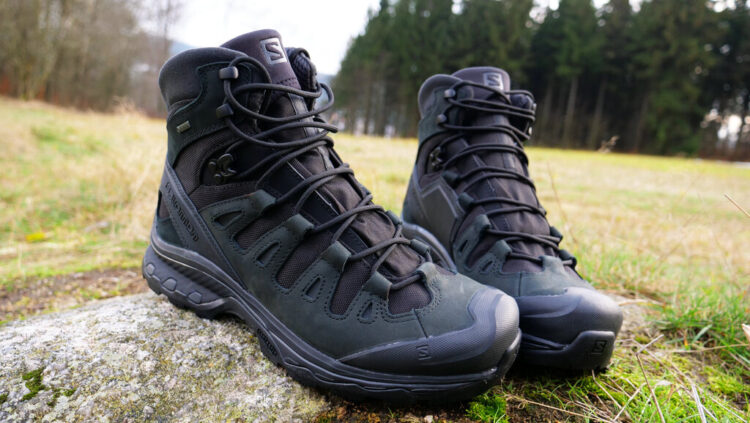
QUEST 4D GTX® FORCES Modeled after their Salomon backpacking footwear these boots offer good support, traction and protection from the weather. Great cushioning, good foot control for active comfort and is built with wide outsoles for stability and works in unison with ankle support. Mesh, textile and nubuck leather. Notice the sturdy toebox for digit protection and the aggressive lugs? Excellent use of eyestays and well-placed lace holders. A protective yet short collar allows for good flexibility when running. Near perfection with use of leather and synthetic overlays. Padded tongue. $239.00
